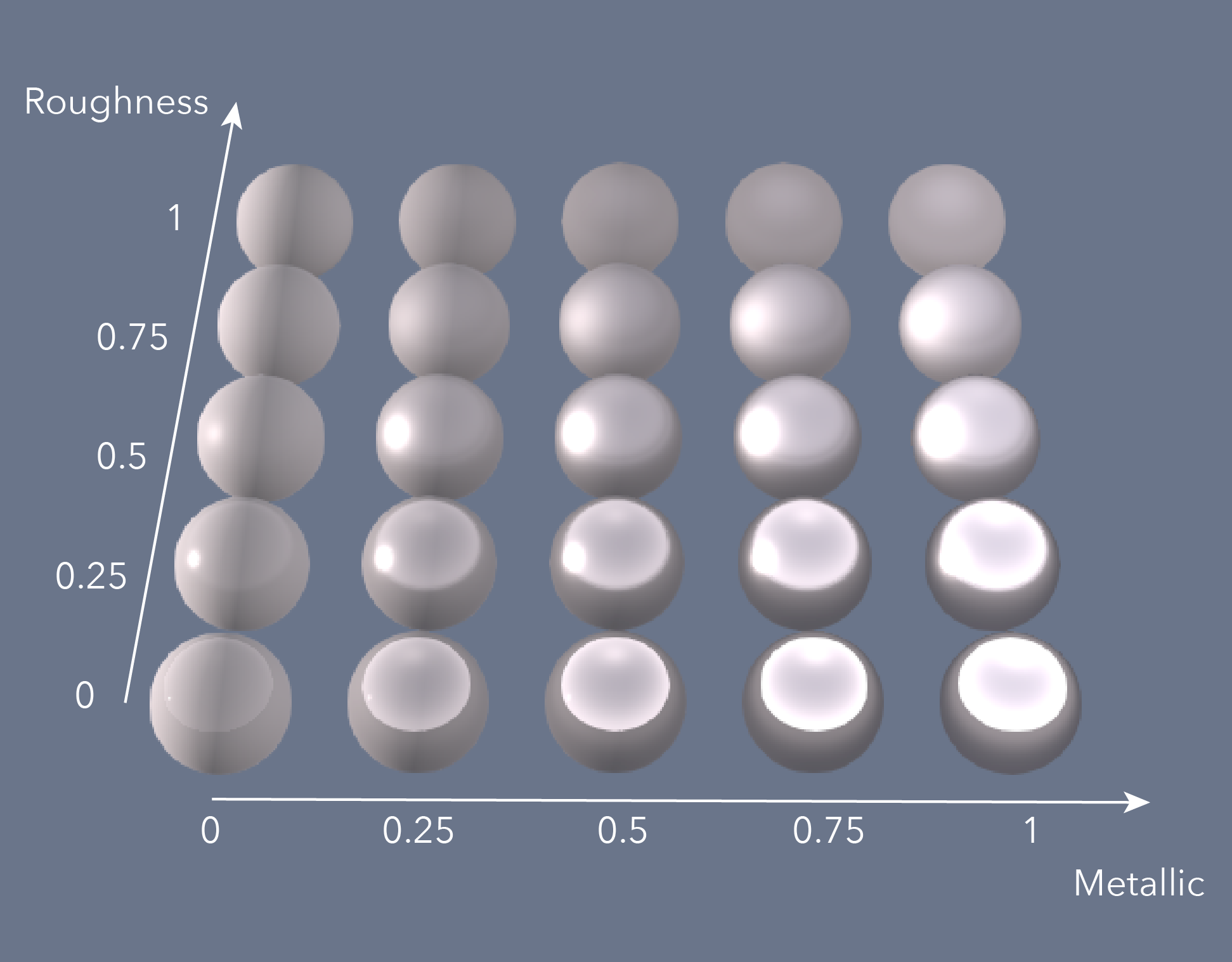MeshMaterialMetallicRoughness
require(["esri/geometry/support/MeshMaterialMetallicRoughness"], function(MeshMaterialMetallicRoughness) { /* code goes here */ });esri/geometry/support/MeshMaterialMetallicRoughnessA material determines how a MeshComponent is visualized. This particular material (based on MeshMaterial) uses the metallic/roughness lighting model to enable physically based lighting. The metallic and roughness properties can be used to model various realistic materials including metals and plastics.
In this image you can see how metallic and roughness property values influence the display of the material:

The metallicRoughnessTexture can be used to map specific metallic/roughness properties on different parts of the model.
Constructors
- new MeshMaterialMetallicRoughness(properties)
- Parameter:properties Objectoptional
See the properties for a list of all the properties that may be passed into the constructor.
Property Overview
| Name | Type | Summary | Class | |
|---|---|---|---|---|
| Number | Specifies how transparency on the object is handled. more details | more details | MeshMaterial | |
| String | Specifies how transparency on the object is handled. more details | more details | MeshMaterial | |
| Color | Specifies a single, uniform color for the mesh component. more details | more details | MeshMaterial | |
| MeshTexture | Specifies a texture from which to get color information. more details | more details | MeshMaterial | |
| String | The name of the class. more details | more details | Accessor | |
| Boolean | Specifies whether both sides of each triangle are displayed, or only the front sides. more details | more details | MeshMaterial | |
| Color | Specifies a single, uniform emissive color for the MeshComponent. more details | more details | MeshMaterialMetallicRoughness | |
| MeshTexture | Specifies a texture from which to get emissive color information. more details | more details | MeshMaterialMetallicRoughness | |
| Number | Specifies how much the material behaves like a metal. more details | more details | MeshMaterialMetallicRoughness | |
| MeshTexture | Specifies a texture from which to get the combined metallic/roughness information. more details | more details | MeshMaterialMetallicRoughness | |
| MeshTexture | Specifies a texture from which to get normal information. more details | more details | MeshMaterial | |
| MeshTexture | Allows to specify a texture to get the occlusion information from. more details | more details | MeshMaterialMetallicRoughness | |
| Number | Indicates how rough the surface of the material is. more details | more details | MeshMaterialMetallicRoughness |
Property Details
Specifies how transparency on the object is handled. If alphaMode is set to either
maskorautothis property specifies the cutoff value below which masking happens (that is, the coresponding part of the Mesh is rendered fully transparent).- Default Value:0.5
Specifies how transparency on the object is handled. See also alphaCutoff.
Type Description opaque Alpha is ignored, and the object is rendered fully opaque. blend Alpha values are used for gradual transparency, blending between the object and its background. mask Alpha values are used for binary transparency, either displaying the object, or its background. See also alphaCutoff. auto The implementation mixes the maskandblendsettings, masking belowalphaCutoffand blending above it.Possible Values:"auto"|"blend"|"opaque"|"mask"
- Default Value:"auto"
Specifies a single, uniform color for the mesh component. This can be autocast with a named string, hex string, array of rgb or rgba values, an object with
r,g,b, andaproperties, or a Color object.
- Autocasts from Object|HTMLImageElement|HTMLCanvasElement|HTMLVideoElement|ImageData|String
Specifies a texture from which to get color information. The texture is accessed using the uv coordinate specified for each vertex in the Mesh.vertexAttributes.
The name of the class. The declared class name is formatted as
esri.folder.className.
Specifies whether both sides of each triangle are displayed, or only the front sides.
- Default Value:true
Specifies a single, uniform emissive color for the MeshComponent. The emissiveColor is added to the base color of the component. This can be autocast with a named string, hex string, array of rgb values, an object with
r,g,bproperties, or a Color object. Note that the alpha channel is ignored for emissive colors.
- emissiveTexture MeshTextureautocastAutocasts from Object|HTMLImageElement|HTMLVideoElement|HTMLCanvasElement|ImageData|String
Specifies a texture from which to get emissive color information. The texture is accessed using the uv coordinate specified for each vertex in the mesh vertex attributes. The colors in the texture are added to the base color of the component. When using both an
emissiveTextureand an emissiveColor their values are multiplied and then added to the base color of the component.
- metallic Number
Specifies how much the material behaves like a metal. Values must be in the range 0 (non metal material) to 1 (metal material). Physically accurate materials are usually either a metal (1) or a non-metal (0) and not something inbetween.
- Default Value:1
- metallicRoughnessTexture MeshTextureautocastAutocasts from Object|HTMLImageElement|HTMLCanvasElement|HTMLVideoElement|ImageData|String
Specifies a texture from which to get the combined metallic/roughness information. The metallic value should be stored in the
bluechannel, while the roughness value should be stored in thegreenchannel. Theredandalphachannels are ignored.The texture is accessed using the uv coordinate specified for each vertex in the mesh vertex attributes.
- Autocasts from Object|HTMLImageElement|HTMLVideoElement|HTMLCanvasElement|ImageData|String
Specifies a texture from which to get normal information. The texture is accessed using the uv coordinate specified for each vertex in the Mesh.vertexAttributes.
- occlusionTexture MeshTextureautocastAutocasts from Object|HTMLImageElement|HTMLVideoElement|HTMLCanvasElement|ImageData|String
Allows to specify a texture to get the occlusion information from. This can be used to simulate the effect of ambient light on the object. The texture is accessed using the uv coordinate specified for each vertex in the mesh vertex attributes. The occlusion value should be encoded in the red channel of the texture.
- roughness Number
Indicates how rough the surface of the material is. Values must be in the range 0 (fully smooth surface) to 1 (fully diffuse surface).
- Default Value:1